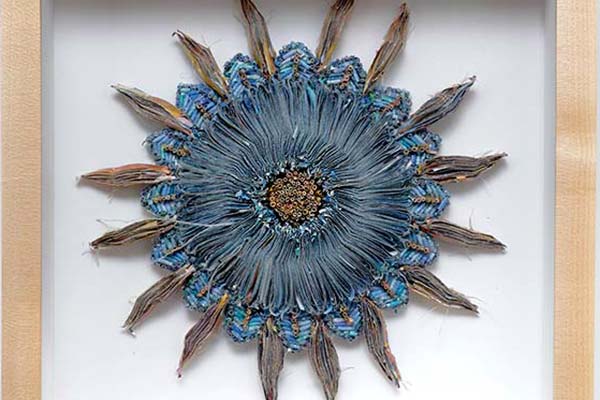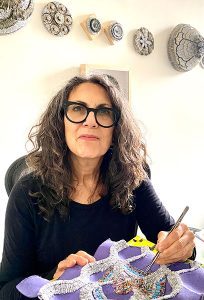 Jaynie Crimmins, a New York City-based artist, creates alternative narratives from quotidian materials. Her work has been shown at Art on Paper, New York City and exhibited at the Sharjah Museum of Art in the United Arab Emirates; SPRING/BREAK Art Show, New York; Governor’s Island Art Fair, New York; the National Museum of Romanian Literature in Bucharest; the Hunterdon Art Museum, New Jersey; and many other museums.
Jaynie Crimmins, a New York City-based artist, creates alternative narratives from quotidian materials. Her work has been shown at Art on Paper, New York City and exhibited at the Sharjah Museum of Art in the United Arab Emirates; SPRING/BREAK Art Show, New York; Governor’s Island Art Fair, New York; the National Museum of Romanian Literature in Bucharest; the Hunterdon Art Museum, New Jersey; and many other museums.
Crimmins has a long history of community work. Prior to the pandemic, she volunteered in the Guggenheim Museum’s Learning Through Art Program. She holds a BA from the State University College at Buffalo (now known as Buffalo State) and a masters from the College of New Rochelle, NY. She is represented by K. Imperial Fine Art in San Francisco and Thomas Deans Fine Art in Atlanta. She shows with the Front Room Gallery and SFA Flat File Gallery in New York. See her work in WTP Vol. IX #2.
Interview with Jaynie Crimmins
By Jennifer Nelson, WTP Feature Writer
Nelson: What led you to use junk mail as a primary medium for your artwork?
Crimmins: In 2009, I began shredding my financial statements and bills in response to the economic crisis that our country was experiencing. Sadness and frustration led me to the practice of rolling, folding, and sewing shredded papers. My materials expanded to include my junk mail as the work shifted to include issues related to the environment and sustainability. Up-cycling and repurposing printed matter that was difficult to recycle—like promotions and catalogs – became a priority and incorporating them has helped me distill the themes of consumer culture and waste through my work.
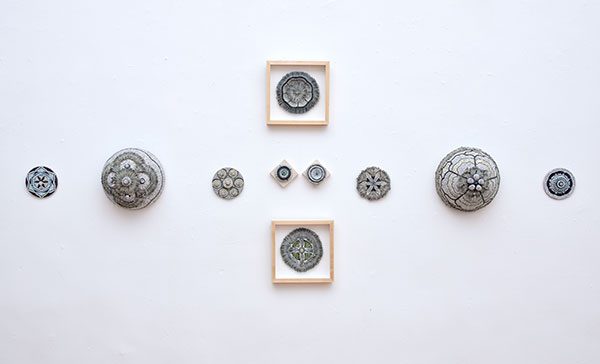
Nelson: Can you talk about your process in creating these works, one that seems to involve great precision and patience in the manipulation of flyers, catalogues and safety envelopes?
Crimmins: My work is very time consuming and mediative. Using a diamond-cut shredder, I shred consumer marketing mailings, including catalogs and security envelopes, then manipulate the shreds in various ways—rolling, folding and sewing. Rolling is done with my non-dominant [right] hand and then individual rolls are placed on a support one-by-one with a tweezer using my left hand, applying an adhesive. When sewing, each shred is folded or left untouched then sewn with a binding needle and thread. The sewing is functional but also adds an unexpected element in the finished work. Leaving ends of threads hanging loose in the completed works creates a breath—their fluidity becomes a contrast to the tightness of the rest of the surface and texture.
Nelson: Your creative practice was put on hold for 15 years while you taught art, raised a family, and worked towards a masters’ degree. Then in 2009, you became a full-time artist. What inspired you for your first series Home Economics and the second one Borrowing from the Future?
Crimmins: My first project, Home Economics, established my use of shredded financial statements as art materials. The series referenced the recession, and the individual titles were extracted from Bob Herbert’s New York Times Op-Eds. Home Economics is also a play on the course all female students were assigned to take when I was in junior high school. I wasn’t fully aware of it at the time, but I realize that this was the first time I toyed with the connection between domestic processes and artistic practices. These have since become much more defined and intentional.
My project Borrowing from the Future was also focused on finances—the title refers to the epidemic of homeowners who found themselves with underwater mortgages. The forms were based upon underwater ecosystems and were intended to call attention to the dying coral reef as well. Borrowing from the Future became a transitional series of works as it broadened the scope, materials and context of the work that followed.
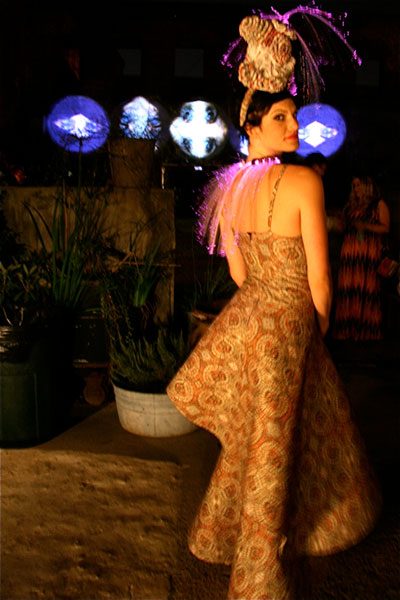
Nelson: You teamed up with fashion designer Cynthia Holder in your series Collaborations. What were the advantages of working with another artist?
Crimmins: I was living in Atlanta when I met Cynthia Holder. We clicked pretty quickly (we’re both native New Yorkers) and I discovered that she had owned her own fashion company in New York City starting in the 1980s. She had also designed Whitney Houston’s gowns for her Bodyguard tour, which made Cynthia a rock star to me! Cynthia is creative, talented and has a great sense of humor. We collaborated on two garment-related “walking installations” and one wall mounted installation.
Generally, creating work is a solitary experience for me, but I found working with Cynthia to be inspiring and expansive. Our combined vision and joint efforts were a true partnership: we examined both the meaning of what we were expressing, as well as what it needed to look like. Working with Cynthia helped get me out of my head and hear other perspectives on creating, constructing and designing.
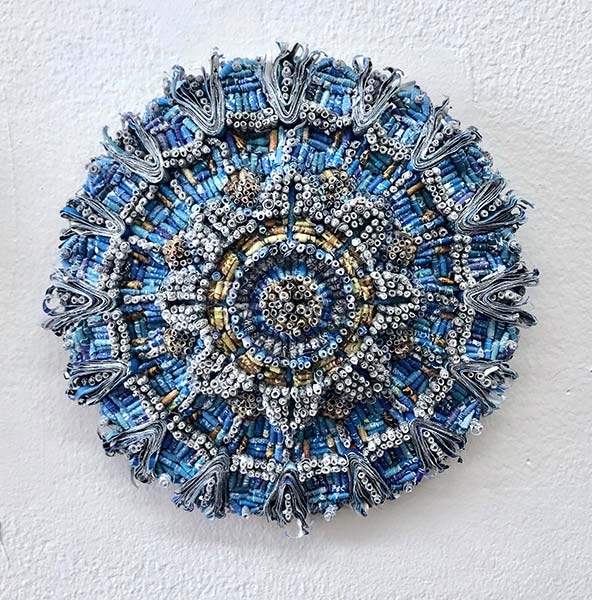
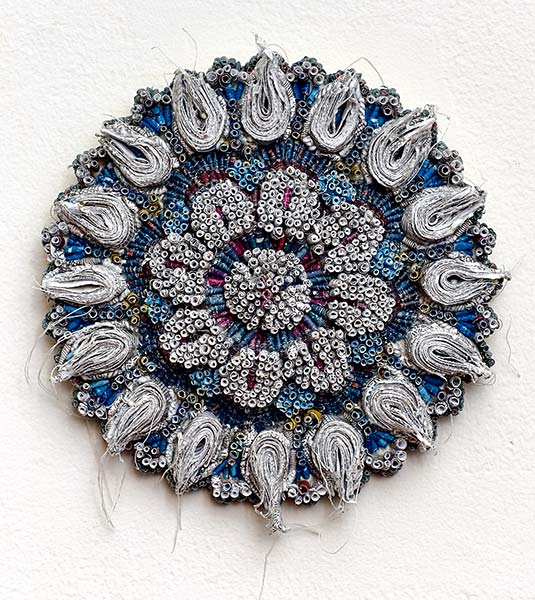
Nelson: Your new project In Search of Beauty uses materials from one catalog, instead of many, which restrains the range of colors. Why did you change techniques and is there an intended message for this series?
Crimmins: This project departed from my usual practice of sorting each shred by color, which allowed complete control over my palette. Each piece from In Search of Beauty uses a single catalog, allowing individual pieces to reference a particular business’s notion of beauty, wealth, taste, or whatever lifestyle they are trying to sell. As a series, In Search of Beauty seeks to personalize the cultural associations in those catalogs and contrast the idea that beauty can be manufactured and purchased.
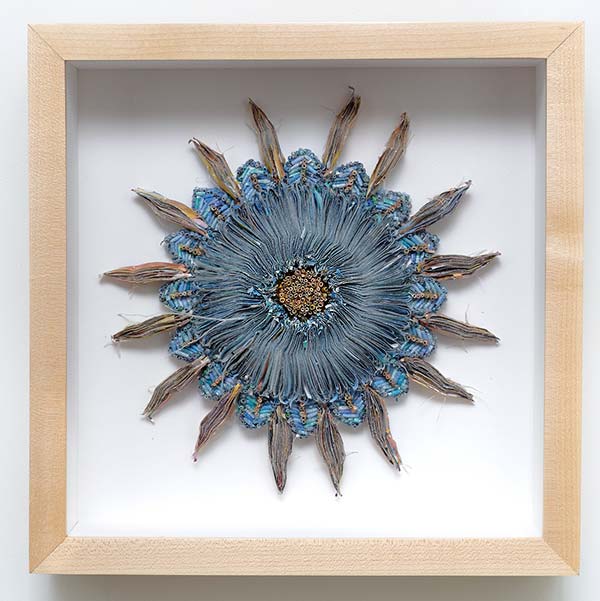
Nelson: How do you see your artwork evolving in the future?
Crimmins: I have been working with shredded personal papers and mail since 2009 and will continue to work with these materials until I believe EVERY permutation possible has been explored. As the work evolves, the subtle changes that seem revolutionary to me are possibly not even noticeable to others!
I am currently engaged in a new project with the working title of Equanimity, defined as an even-minded mental state or inclination toward all experiences or objects, regardless of their origin or pleasant, unpleasant, or neutral connotations.
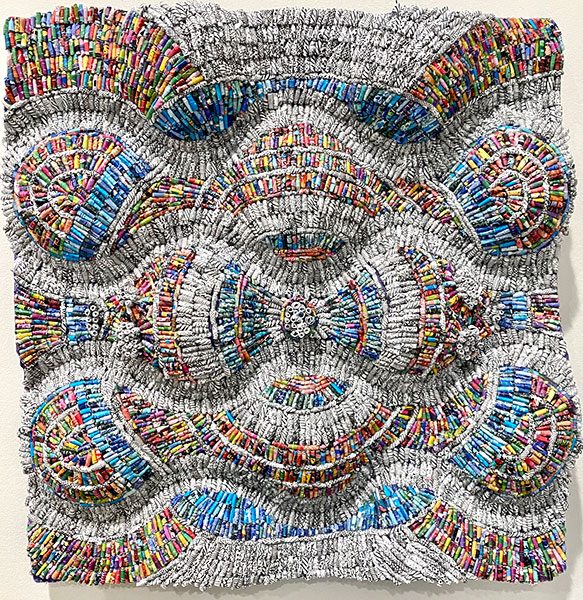
Click here to read more interviews with WTP artists
Copyright 2021 Woven Tale Press LLC. All Rights Reserved

